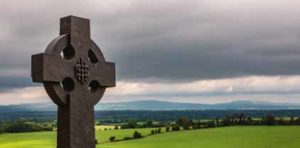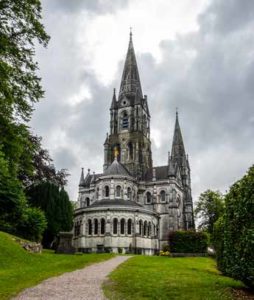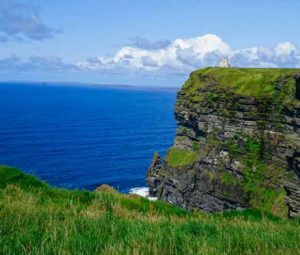Ron McGinty takes us to Ireland Land of His Ancestors
 My great grandfather, John McGinty, was born in Donegal, Ireland in 1831 and immigrated to the United States with his family at the age of seventeen. This was during the potato famine when many fled to the United States and Canada. The ships were called “Coffin Ships” because they were overcrowded, disease-ridden, and lacked food and water. Over one million Irishmen died in Ireland, and another one million left the country. This accounted for about 25% of the population. There are many theories on how the British caused the crops to be infected with fungi because they planted new crops not indigenous to the area. Most of the land was owned by the British.
My great grandfather, John McGinty, was born in Donegal, Ireland in 1831 and immigrated to the United States with his family at the age of seventeen. This was during the potato famine when many fled to the United States and Canada. The ships were called “Coffin Ships” because they were overcrowded, disease-ridden, and lacked food and water. Over one million Irishmen died in Ireland, and another one million left the country. This accounted for about 25% of the population. There are many theories on how the British caused the crops to be infected with fungi because they planted new crops not indigenous to the area. Most of the land was owned by the British.
My great grandfather, like many Irishmen, found prosperity in life. He was known as the “Great Levee Builder,” he engineered the construction of the Mississippi River levee and was responsible for many of the railway lines in the South. He became a part of New Orleans’ history. A six-foot portrait is displayed in the Cabildo Museum by Jackson Square during New Orleans history month. He left us the family tomb in Metairie Cemetery where all his descendants are buried.
Builder,” he engineered the construction of the Mississippi River levee and was responsible for many of the railway lines in the South. He became a part of New Orleans’ history. A six-foot portrait is displayed in the Cabildo Museum by Jackson Square during New Orleans history month. He left us the family tomb in Metairie Cemetery where all his descendants are buried.
 Today, Ireland ranks fifth in the world for GDP per capita, $68,710. An ironic lesson for me, the country is divided into two sections. Northern Ireland is a self-governing jurisdiction as is the southern part, the Republic of Ireland. While the currency in the north is the British Pound, the south uses the Euro. I frequently received history lessons in local pubs. There are still strong feelings, but was told, “We are all Irishmen!” and have another Guinness. The people of Ireland are the kindest and most fun-loving people I have ever encountered.
Today, Ireland ranks fifth in the world for GDP per capita, $68,710. An ironic lesson for me, the country is divided into two sections. Northern Ireland is a self-governing jurisdiction as is the southern part, the Republic of Ireland. While the currency in the north is the British Pound, the south uses the Euro. I frequently received history lessons in local pubs. There are still strong feelings, but was told, “We are all Irishmen!” and have another Guinness. The people of Ireland are the kindest and most fun-loving people I have ever encountered.
Europe is always thought-provoking for its history and ageless beauty. My journey to Ireland was no different, bursting with castles and exquisite vivid terrains. I usually travel alone for my photography trips, but this time was a planned tour to see southern Ireland. Accordingly, I took about three hundred pictures. This is about ten percent of my routine photo expeditions because we were always moving in a cluster. The benefit, I covered many miles with a delightful group of co-travelers.
 The highpoints were plentiful. The Blarney Stone is not a wall but is a small rock slab built into the top of Blarney Castle. You virtually hang backwards over the side of the castle to kiss it. The legend says you will receive the gift of eloquence (blarney) if you kiss it. One of the most photographed areas is the Cliffs of Moher, which captures the charm and raw beauty of Ireland. We began in Dublin, a big city, but very accessible on foot. The oldest pub is the Brazen Head Pub established in 1198. The Guinness family began making its dark Irish stout beer in 1759 and sells over 220 million gallons a year.
The highpoints were plentiful. The Blarney Stone is not a wall but is a small rock slab built into the top of Blarney Castle. You virtually hang backwards over the side of the castle to kiss it. The legend says you will receive the gift of eloquence (blarney) if you kiss it. One of the most photographed areas is the Cliffs of Moher, which captures the charm and raw beauty of Ireland. We began in Dublin, a big city, but very accessible on foot. The oldest pub is the Brazen Head Pub established in 1198. The Guinness family began making its dark Irish stout beer in 1759 and sells over 220 million gallons a year.
A tour of the brewery is a must. I would sum the trip up with a few lasting thoughts, old castles, cathedrals, fishing villages, and landscapes to capture the imagination. I am planning a return
journey to Northern Ireland. Soon is my Istanbul, Turkey trip with private photography guides… keep an eye out for the story in Life in Naples.
 WWW.RONMCGINTY.COM
WWW.RONMCGINTY.COM 



Leave a Reply
Want to join the discussion?Feel free to contribute!